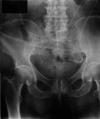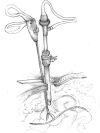Removal of an intraperitoneal foreign body using a single port laparoscopic procedure
- PMID: 21902989
- PMCID: PMC3148885
- DOI: 10.4293/108680811X13071180407113
Removal of an intraperitoneal foreign body using a single port laparoscopic procedure
Erratum in
- JSLS. 2012 Jan-Mar;16(1):189
Abstract
Background and objectives: To remove a foreign body from the peritoneal cavity in laparoscopic surgery, 2 or 3 ports are usually used. We have recently performed such a removal using a single 10-mm transumbilical port, a 0-degree laparoscope, a Farabeuf retractor, and a laparoscopic grasping forceps.
Methods: Two patients with ventriculoperitoneal shunt catheter (V-P shunt) were admitted to our unit during the last year. They previously had a shunt catheter implanted for hydrocephalus of unknown cause. The complete migration of the ventriculoperitoneal shunt catheter into the peritoneal cavity was observed in these patients 12 and 7 years after the implantation. The laparoscopic removal of the migrated catheter was decided on. Its presence and location were confirmed by the use of a 0-degree laparoscope, through a 10-mm trocar port. The catheter was held and pulled out using a grasping forceps that was pushed in just beside the trocar port.
Conclusion: The laparoscopic approach enables safe removal of a foreign body in the peritoneal cavity. The procedure can be performed using a single port.
Figures




Similar articles
-
Laparoscopic removal of a foreign body in the pelvic cavity through one port using a flexible cholangioscope.Dig Surg. 2009;26(3):205-8. doi: 10.1159/000219325. Epub 2009 May 20. Dig Surg. 2009. PMID: 19468226
-
Laparoscopic retrieval of disconnected ventriculoperitoneal shunt catheters: report of two cases.Surg Laparosc Endosc. 1995 Aug;5(4):263-6. Surg Laparosc Endosc. 1995. PMID: 7551276
-
Laparoscopic removal of two dislocated ventriculoperitoneal catheters: case report.Minim Invasive Neurosurg. 1999 Jun;42(2):86-8. doi: 10.1055/s-2008-1053377. Minim Invasive Neurosurg. 1999. PMID: 10422704
-
Transoral migration of the inferior end of a ventriculoperitoneal shunt: A case report with literature review.Neurochirurgie. 2018 Jun;64(3):203-205. doi: 10.1016/j.neuchi.2018.02.005. Epub 2018 Apr 27. Neurochirurgie. 2018. PMID: 29709372 Review.
-
[Laparoscopic retrieval of a dislocated ventriculoperitoneal shunt catheter: report of three cases and a review of the literature].No Shinkei Geka. 1997 Jul;25(7):629-33. No Shinkei Geka. 1997. PMID: 9218257 Review. Japanese.
Cited by
-
Use of Mini-Percutaneous Nephrolithotomy Technique to Remove Extra-Peritoneal Foreign Bodies.Am J Case Rep. 2021 Feb 24;22:e929731. doi: 10.12659/AJCR.929731. Am J Case Rep. 2021. PMID: 33626032 Free PMC article.
-
Laparoscopic retrieval of unusual intra-abdominal foreign bodies in children.J Indian Assoc Pediatr Surg. 2016 Oct-Dec;21(4):184-186. doi: 10.4103/0971-9261.186549. J Indian Assoc Pediatr Surg. 2016. PMID: 27695212 Free PMC article.
-
Removal of a retroperitoneal foreign body through single port laparoscopy using nephroscope.Turk J Urol. 2017 Sep;43(3):386-389. doi: 10.5152/tud.2017.14306. Epub 2017 Aug 3. Turk J Urol. 2017. PMID: 28861317 Free PMC article.
References
-
- Esposito JM. Removal of polyethylene catheters under laparoscopic supervision. J Reprod Med. 1975;14:174. - PubMed
-
- Witmore RJ, Lehman GA. Laparoscopic removal of intraperitoneal catheter. Gastrointest Endosc. 1979;25:75–76 - PubMed
-
- Kurita N, Shimada M, Nakao T, et al. Laparoscopic removal of a foreign body in the pelvic cavity through one port using a flexible cholangioscope. Dig Surg. 2009;26:205–208 - PubMed
-
- Cope C, Kramer MS. Laparoscopic removal of dialysis catheter. Ann Intern Med. 1974;81:121. - PubMed
-
- Smith DC. Removal of an ectopic IUD through the laparoscope. Am J Obstet Gynecol. 1969;105:285–286
Publication types
MeSH terms
LinkOut - more resources
Full Text Sources
